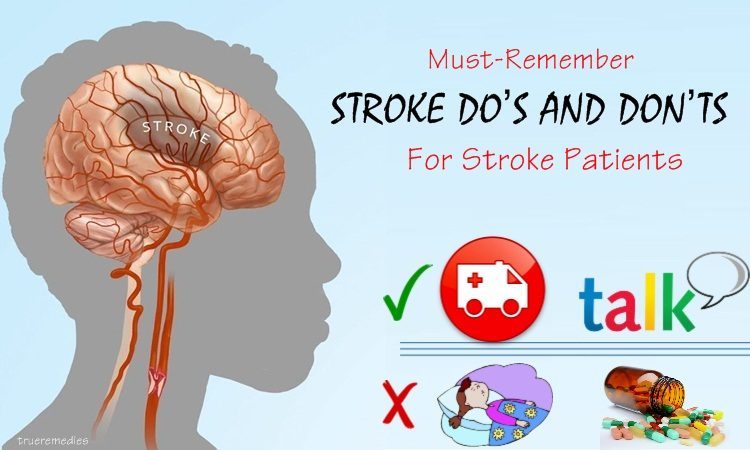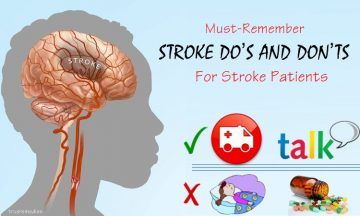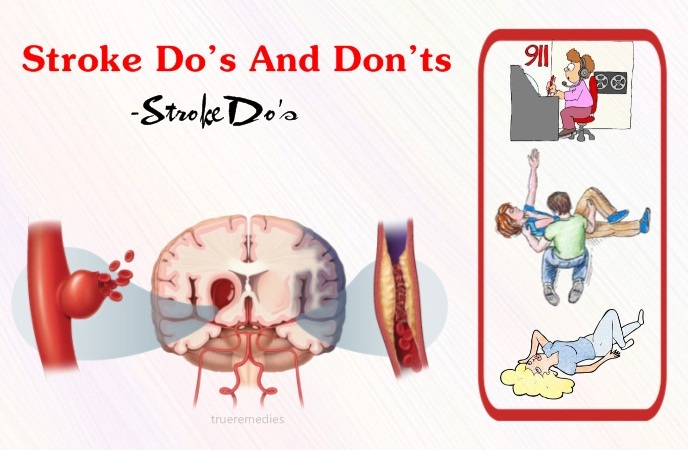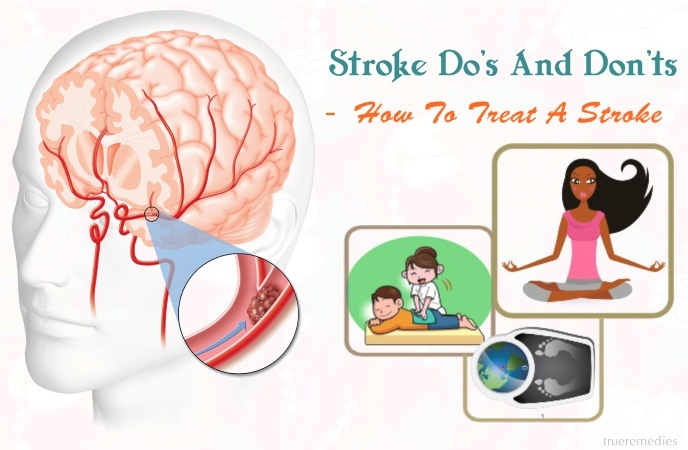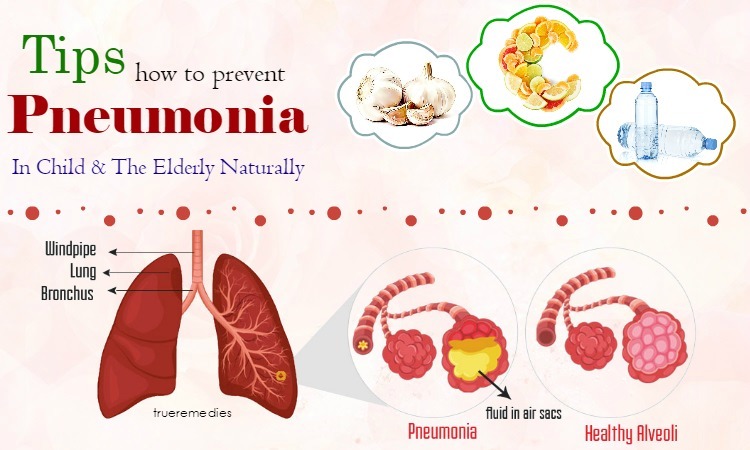Updated: 11/14/2019
Contents
A stroke is a life threatening disease because it can happen anywhere, anytime and gives no warning signs of occurring. A stroke occurs when a blood vessel that supplies the brain is clogged or ruptured, which interrupts blood and oxygen flow to the brain. Stroke may result in death or long-term disabilities such as paralysis or motor control, sensory disturbances, aphasia or loss of speech, emotional disturbances, etc[1]. It is a frightening experience not only for people going through it but also for those who witness it. In this article, TrueRemedies will introduce you to useful information about the 12 stroke do’s and don’ts for stroke patients to follow. However, before learning the tips, please have a look at some of the symptoms of a stroke. Let's get started!
- 27 tips how to maintain a healthy heart rate & prevent heart disease
- 23 tips how to increase good cholesterol (HDL) levels naturally
Symptoms Of A Stroke
It is important for you to know some basic signs and symptoms of how a stroke looks like. A person who suffers from a stroke may have some of the signs below[2]:
- Paralysis or numbness of arms, legs, or face, especially on one side of the face
- Suddenly blurred vision in one eye
- Difficulty in speaking, swallowing, etc.
- Unexplained fall, loss of balance, and dizziness
- Sudden, severe headaches with no plausible cause
- Drowsiness and confusion
- Loss of consciousness
The 12 Must-Remember Stroke Do’s And Don’ts For Stroke Patients
I. Stroke Do’s
1. Call An Ambulance
The first thing in the list of the stroke do’s and don’ts for stroke patients is definitely to call an ambulance. A way to check if someone is having a stroke, is the FAST acronym, which stands for[3]:
Face: Ask sufferers to smile. If it is a stroke, one side of their face can be numb or droop.
Arm: When raising both arms, one arm of a person with a stroke will be drifting downward
TrueRemedies Partner Solutions

Need a Help from the Leading Expert Online, Available 24/7?
They’re all here and ready to answer your questions online or by phone. Keep asking questions until you get the answer you need.
Speech: A person with a stroke has slurred speech.
Time: Time is a crucial thing. If you see these signs, call 911 immediately.
2. Use The Word ‘Stroke’
Even when you are uncertain if it is a stroke; let the dispatcher know that it could be a stroke to give the paramedics more time to prepare.
3. Keep Track Of Symptoms
The patient may not be able to communicate at the hospital; you should try to provide as much information as possible. Remember all their symptoms, including when you first noticed these symptoms. If the person has known medical conditions, you should share that information with hospital staff. These conditions might include heart disease, high blood pressure, diabetes, and sleep apnea.
4. Note The Time You See The First Symptoms
It is crucial to remember what time you first saw the symptoms because this helps the doctors to decide whether they give the patient a clot-busting medication named tPA[4] [5]. It may help to reverse or stop the signs from developing. The medication must be taken within 4.5 hours after the start the first symptoms. Informing the doctors or paramedics about the time when those symptoms started may help the patient get the right treatment.
5. Follow the DRSABCD Plan
D – Danger – Check for danger to your loved one or people around him/her.
R – Response – Check for their response, if they are unable to talk, grasp their hands and ask them to squeeze a yes or no to your questions.
S – Send – Try to send for help instantly.
A – Airways – Check the airways of the patient to ensure that he/she is able to breathe freely. In case the airway isn’t clear, try to keep him/her on his/her side and put his/her arm under him/her at the right angle to his/her body.
B – Breathing – Check for his/her breathing. You can see if his/her chest is rising and falling, or feel his/her breath on your cheek.
C – CPR – If you feel his/her pulse has stopped, give CPR. Most stroke patients don’t need CPR. However, if your spouse or friend is unconscious when you find him/her, you should check his/her pulse and breathing. In case you find none, try to call 911 and then start CPR immediately while you are waiting for an ambulance to arrive.
Also, you can ask the 911 dispatcher to walk you through how to practice CPR, which includes repeated, steady chest compressions as per the American Heart Association
D – Defibrillator – If the patient isn't responding to the CPR, you should inform the paramedics or doctors about it. Then they can use the defibrillator.
6. Talk To The Person Having A Stroke
When waiting for the ambulance, you should try to gather information from the patient as much as possible if they are able to communicate. You can ask about any medications they are taking, health conditions they suffer from, and known allergies. You should write the information down so that you can tell it to the doctors.
7. Encourage Him To Lie Down
If he/she is standing or sitting, you should encourage him/her to lie down on one side with the head elevated. This position helps to promote the flow of blood to the brain. However, remember not to move him/her if he/she is fallen. To keep him/her comfortable, you can loosen restrictive clothing.
8. Describe What Happened To The Doctor/Paramedics
It is very important for you to be clear about anything you saw when communicating with the doctors or paramedics, including when the signs started and when was the last time this patient seemed normal. In case the patient woke up with a stroke, when he/she went to bed is the last time he/she seemed normal. If you know, he/she has health concerns, including: diabetes, high blood pressure, certain drug allergies, uses any medications. Share the information with the doctors immediately.
9. Stay Calm
It is important for you to keep talking to the patient and ensure that he/she is calm. You don't want them to get anxious because that increases heart rate, which can put him/her in more danger. You should stay calm and ensure that you're doing everything you can to get the patient to the hospital as soon as possible to avoid any dangerous consequences from the stroke.
II. Stroke Don’ts
While people can follow a set of instructions for first aid when someone is experiencing a stroke, the do’s and don’ts of this disease are not widely known. So, here are several things you should avoid when you think someone is having a stroke.
1. Let The Patient Drive To The Hospital
The symptoms of stroke may be subtle in the first period. The person can realize something is wrong, yet not suspect a stroke. In case you believe he/she is suffering from a stroke, don’t allow him/her to drive to the hospital. Instead, call 911 and wait for their help.
2. Give Medication, Food, Or Drinks
There are basically two types of strokes:hemorrhagic stroke (resulting from a ruptured blood vessel) and ischemic stroke (resulting from a blood clot in the blood vessel). In fact, ischemic stroke accounts for over 80%[6]; however, if you belong to the 20% of people with hemorrhagic stroke[7], aspirin may make things worse. Also, you have to wait until you and the patient get to the hospital, get a CAT scan and in order to then use medication.
Moreover, strokes sometimes affect the ability to swallow; therefore, giving them any food or drink may make them aspirate and choke.
3. Let The Person Sleep
Stroke survivors often complain that they suddenly feel very sleepy when it first happens. A lot of sufferers come in to the hospital and say that they slept for several hours before because they're too tired. However, time is the essence. The medication that can be given to a person with a stroke is time-sensitive. So, advise he/she that they shouldn't go to sleep, and he/she should call their doctor immediately. They should go to the emergency room right away. Also, no matter how much a person tries to advise you to avoid taking the patient to the hospital, remember to go anyways.
How To Treat A Stroke
1. Manage Healthy Weight
It is good for stroke patients to maintain a healthy weight, which helps to manage the risk factors for stroke. When most of the body fat of a person rests around the waist rather than the hips, he/she has a higher risk of heart disease. The waist size of women more than 35 inches and the waist size of men more than 40 inches confers a greater risk of cardiovascular disease including stroke.
The National Heart, Lung, and Blood Institute found that weight loss may help to improve blood pressure readings, reduce cholesterol levels, reduce the risk of type 2 diabetes, and reduce body fat.
You should visit your doctor to know your ideal weight.
2. Reduce Stress
The American Heart Association found that stress is linked to a notably increased risk of a stroke attack[8]. Therefore, you should learn relaxation techniques to decrease both physical and mental stress.
3. Massages
Massages may aid in increasing blood flow to your affected area, especially for muscle problems related to stroke. According to a study, massages might relieve pain, increase health, and improve movement after a stroke attack[9].
In several studies in China, external counterpulsation treatments may help to enhance recovery in people who have suffered from an ischemic stroke[10].
External counterpulsation treatments mean wrapping cuffs around your thighs, hips, and calves. The cuffs inflate and deflate, which creates massage-like sensations and help to increase blood flow to your brain.
The above is information on the stroke do’s and don'ts for stroke patients. With this article, we hope that it can give you the first aid to help patients prevent unpredictable complications. If you have any questions about the article, please contact us immediately by dropping a comment in the comment box. For other articles about the do's and don’ts or related-health issues, please visit our News And Fact page.
Read more: 5 Best Home Remedies To Help With Cervical Spondylosis. This article was medically reviewed/ fact checked by Dr. Brent Wells and Dr. Shawn Meirovici N.D.

